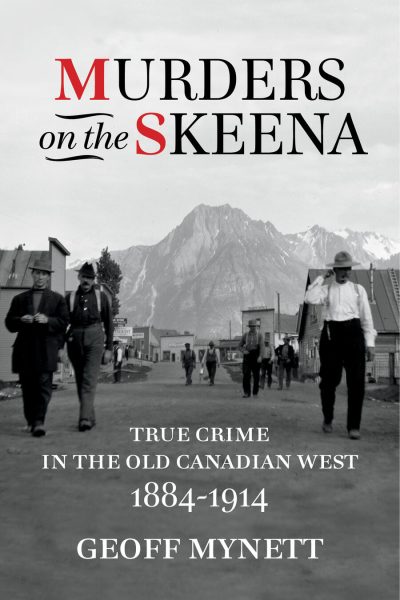
Murders on the Skeena: True Crime in the Old Canadian West, 1884-1914
Review By Tyler McCreary
March 21, 2023
BC Studies no. 217 Spring 2023 | p. 126-128
Over the last few years, Geoff Mynett has emerged as the leading popular historian of the Hazelton area of Northwestern British Columbia. In Murders on the Skeena, Mynett, a retired lawyer, shows his particular penchant for questions of criminal law on the Northwestern frontier. He particularly focuses on the thirty-year span from when white prospectors began to penetrate the region to the arrival of the railway.
The most instructive portions of the book deal how a series of murders in the 1880s reflect “a clash between the laws and customs of the encroaching non-Indigenous settlers and those of the Gitxsan people” (10). In 1884, Haatq killed Amos Youmans, a white trader who had employed his Gitxsan son when he died in a tragic river accident. Under Gitxsan law, Youmans had to compensate the family for Billy’s death. To avoid this financial expense, Youmans concealed the death, entitling Haatq to retaliate under Gitxsan law. Canadian courts judged it murder, jailing Haatq. Then in 1888, a complex entanglement of Gitxsan laws of retribution with settler criminal law resulted in a series of four deaths, most prominently involving the shooting of Kamalmuk by Constable Daniel Franklin Green in a botched arrest. Both these cases highlighted the complex relations between Gitxsan and settler orders, as the newcomers sought to assert the supremacy of Canadian law over Indigenous society.
In subsequent cases, spanning from the 1890s to the 1910s, Mynett examines the difficulties of maintaining law on a distant frontier. William Gordon escapes justice after murdering his partner in a mining enterprise because no body could be found. William Grinder defrauds a number of credulous prospectors. Mynett revisits the well-known story of Gunanoot, who evaded settler justice for double homicide by retreating to remote Gitxsan territories (Williams, 1982; Mynett, 2021). In this account, Mynett details the efforts of Constable James Kirby to pursue him in the days immediately following the murders of Alex MacIntosh and Max Leclair. The murders of Oscar Soderberg and Ernest Kennett similarly go unsolved.
Describing two Union Bank robberies, Mynett contrasts police and citizen action. In the first, locals initially organize in pursuit of the bandits but decide to defer to the police. The authorities take another day to assemble, accidentally shoot an innocent man, and fail to apprehend the thieves. In the second, Mynett is unabashed in castigating police incompetence and lauding the heroism of community members. The majority of the villains in this case are killed or apprehended by Hazelton locals. A single fugitive escapes after late-arriving government agents stopped the local posse because they lack legal authority. Mynett’s lionization of the self-organization of frontiersmen is explicit. He quotes the local Omineca Herald, “this town is peopled by those who are real men, prepared at all times to take up the fight” (205).
Finally, Mynett closes with a discussion of the trial of the Gitxsan man John May in the murder of settler Albert Taylor. Here he focuses on uncertainties in the case related to the testimony of May’s brother. However, focusing on the legal technicalities of entering evidence, Mynett underemphasizes some of language translation issues that also shaped the case.
Overall, Murders on the Skeena presents a compelling popular history that shows the conflicts and limits of extending criminal justice to Northern British Columbia. However, certain biases mark the book. Mynett relies on police and court archival records and often disregards relevant Indigenous oral histories. At points, he positions his accounts as a counterpoint to prior research based on Gitxsan oral histories (for instance, Galois, 2007; Sterrit, 2016). He also fails to reference certain critical studies on Gitxsan-settler relations, which discuss circumstances around some of the cases he explores (for instance, Foster, 1994; Galois, 1993; Mills, 2008). Nevertheless, Mynett’s book is eminently readable and serves to bring attention to the complexity of applying settler law in the provincial North in the late-nineteenth and early-twentieth century.
References
Foster, H. 1994. “The Queen’s Law is Better Than Yours”: International Homicide in Early British Columbia. In Essays in the History of Canadian Law, Vol. V: Crime and Criminal Justice, eds. J. Phillips, T. Loo, and S. Lewthwaite, 41–111. Osgoode Society for Legal History.
Galois, R.M. 1993. The History of the Upper Skeena Region, 1850 to 1927. Native Studies Review 9 (2):113–183.
——. 2007. Gitxsan Law and Settler Disorder: The Skeena River ‘Uprising’ of 1888. In New Histories for Old: Changing Perspectives on Canada’s Native Pasts, eds. Ted Binnema and Susan Neylan, 220-248. UBC Press.
Mills, P. Dawn. 2008. For Future Generations: Reconciling Gitxsan and Canadian Law. Purich.
Sterritt, Neil J. 2016. Mapping My Way Home: A Gitxsan History. Creekstone Press.
Mynett, Geoff. 2021. Pinkertons’ and the Hunt for Simon Gunanoot. Caitlin Press.
Williams, David Ricardo. 1982. Trapline Outlaw: Simon Peter Gunanoot. Sono Nis Press.
Publication Information
Mynett, Geoff. Murders on the Skeena: True Crime in the Old Canadian West, 1884-1914. Qualicum Beach, BC: Caitlin Press, 2022. 256 pp. $24.95 paper.
